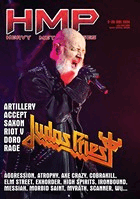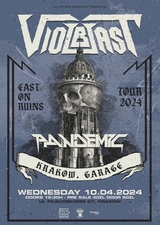DIMMA - Þögn [ENG]
(2021 GB)
Autor: Sam O’Black
Tracklist:
Nætursól
Þögn
Skuggamyndir
Andvaka
Paradísarheimt
Minn þyrnikrans
Augun mín
Almyrkvi
Svartur fugl
Þín spor
In the second half of 2018, Judas Priest offered Dimma to perform together, on the same stage. Tickets were on sale for a while, but the concert never happened. Still, the fact that the Metal Gods involved Dimma in their plans spoke volumes of Dimma’s potential, especially that back then Priest were supported by such legends as Uriah Heep, Sabaton, Deep Purple, Saxon (I’m not talking about festivals). Even then, Dimma had an excellent original repertoire, and in mid-2021 they outshined all of their own records. By postponing the release, they perfected “Þögn” so much that it was unanimously called the best studio album in Dimma’s discography. The Polish internet portal “Stacja Islandia” (“Station Iceland”) has already vividly described the musical assets of “Þögn” (be sure to check it out), so I’d like to focus more on identifying where this longplay falls among the multitude of recent NWOTHM albums. First of all, it’s not so obvious that Dimma even represents the New Wave of Traditional Heavy Metal. When listening to “Þögn” casually – only casually – we may think of Hungarian or GDR (East German) heavy/hard rock, and considering the band’s debut was in 2005, we can also jump at conclusions. The thing is that when listening to Singaporean Witchseeker or Polish Shadow Warrior, I immediately sense they’re NWOTHM, which is not the case at all with Dimma. Perhaps because more mature musicians produce more mature sounds? Herman Frank’s first solo album was released in 2009. It undoubtedly feels like traditional heavy metal, but nobody would seriously suggest he’s part of NWOTHM. That's because decades of playing instruments have their effect. Indeed, the founders of Dimma, guitarist Ingó Geirdal and his brother, bassist Silli Geirdal, were forming their first bands not at the time of NWOTHM, but of NWOBHM. This is their magnum opus, rather than some fun (their Stripshow’s LP “Late Nite Cult Show” from 1996 could be called fun, but even this music was already of high quality). At the same time – which is exciting – Dimma has a chance to appear in the wider conscience of global heavy metal scene for the first time. Their concerts in New York and St. Petersburg didn’t turn the tables. It would be amazing if the music in “Þögn” did. So far, globally, Dimma is one of the most underrated heavy metal bands in the world. They say that art speaks for itself, but only if you listen, if you know it’s there. If Icelanders could be so delighted they gave a standing ovation in the (sold out) venue of Harpa, why wouldn’t the Polish audience like this music? The language is not a barrier, everybody know that the Japanese and Brazilians have been listening to English heavy metal almost since its beginnings. So where does “Þögn” fall among the multitude of recent NWOTHM albums? From the Polish perspective, nowhere. Let’s change it!
(6/6)
Sam O’Black













